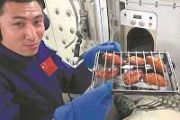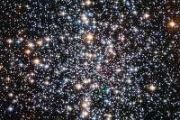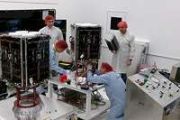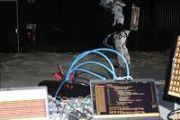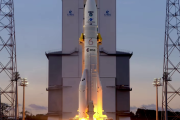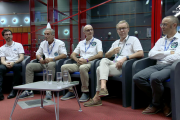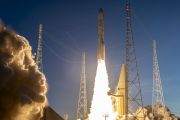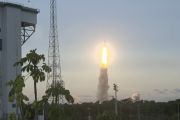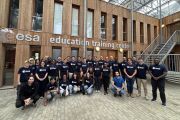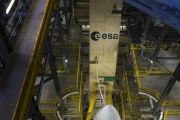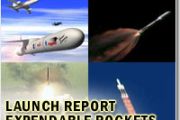
Copernical Team
Smart T-shirt measures astronauts' vital signs
 At the end of October 2021, it will be time for German astronaut Matthias Maurer to travel to the International Space Station (ISS) on board a SpaceX Crew Dragon. His first ISS mission has been named 'Cosmic Kiss'. Thirty-six experiments developed in Germany have been planned for his mission. One of them is Wireless Compose 2 (WICO2), which has been designed and prepared by the German Aerospace
At the end of October 2021, it will be time for German astronaut Matthias Maurer to travel to the International Space Station (ISS) on board a SpaceX Crew Dragon. His first ISS mission has been named 'Cosmic Kiss'. Thirty-six experiments developed in Germany have been planned for his mission. One of them is Wireless Compose 2 (WICO2), which has been designed and prepared by the German Aerospace Eutelsat completes OneWeb equity investment
 Eutelsat Communications confirms the closing of its $550m equity investment in OneWeb announced on April 27, 2021. Subject to completion of the subsequently announced investments in OneWeb by Bharti and Hanwha, Eutelsat will hold a 17.6% stake.
Rodolphe Belmer, Chief Executive Officer of Eutelsat, said: "We are delighted to close this investment in OneWeb, giving us a foothold in the Low E
Eutelsat Communications confirms the closing of its $550m equity investment in OneWeb announced on April 27, 2021. Subject to completion of the subsequently announced investments in OneWeb by Bharti and Hanwha, Eutelsat will hold a 17.6% stake.
Rodolphe Belmer, Chief Executive Officer of Eutelsat, said: "We are delighted to close this investment in OneWeb, giving us a foothold in the Low E Winds delay South Australian launch attempt
 UPDATE: Friday's launch attempt was delayed due to strong upper winds. - The Australian Government has given regulatory approval for a commercial rocket launch to take place from a newly licensed launch facility in South Australia.
Taiwanese company tiSPACE will conduct a test flight of its Hapith I - a 10m, two-stage, sub-orbital rocket - from the Whalers Way Orbital Launch Complex, which is operated by Southern Launch. The launch is now scheduled to take plac
UPDATE: Friday's launch attempt was delayed due to strong upper winds. - The Australian Government has given regulatory approval for a commercial rocket launch to take place from a newly licensed launch facility in South Australia.
Taiwanese company tiSPACE will conduct a test flight of its Hapith I - a 10m, two-stage, sub-orbital rocket - from the Whalers Way Orbital Launch Complex, which is operated by Southern Launch. The launch is now scheduled to take plac Parker Solar Probe team sheds new light on structure, behavior of inner solar system dust
 Scientists using data from NASA's Parker Solar Probe have assembled a comprehensive picture of the structure and behavior of the large cloud of space dust that swirls through the innermost solar system - and the new insight offers clues to similar clouds around stars across the universe.
Research teams led by Jamey Szalay of Princeton University and Anna Pusack of University of Colorado, L
Scientists using data from NASA's Parker Solar Probe have assembled a comprehensive picture of the structure and behavior of the large cloud of space dust that swirls through the innermost solar system - and the new insight offers clues to similar clouds around stars across the universe.
Research teams led by Jamey Szalay of Princeton University and Anna Pusack of University of Colorado, L Earthlike planets in other solar systems? Look for moons
 Finding an exact copy of the Earth somewhere in the universe sounds like a far-fetched notion, but scientists believe that because Earth happened in our solar system, something similar is bound to exist someplace else. University of Illinois Urbana-Champaign researcher Siegfried Eggl and his colleagues say orbiting moons may play a key role in keeping planets habitable over long periods and iden
Finding an exact copy of the Earth somewhere in the universe sounds like a far-fetched notion, but scientists believe that because Earth happened in our solar system, something similar is bound to exist someplace else. University of Illinois Urbana-Champaign researcher Siegfried Eggl and his colleagues say orbiting moons may play a key role in keeping planets habitable over long periods and iden ESO captures best images yet of peculiar "dog-bone" asteroid
 Using the European Southern Observatory's Very Large Telescope (ESO's VLT), a team of astronomers have obtained the sharpest and most detailed images yet of the asteroid Kleopatra. The observations have allowed the team to constrain the 3D shape and mass of this peculiar asteroid, which resembles a dog bone, to a higher accuracy than ever before. Their research provides clues as to how this aste
Using the European Southern Observatory's Very Large Telescope (ESO's VLT), a team of astronomers have obtained the sharpest and most detailed images yet of the asteroid Kleopatra. The observations have allowed the team to constrain the 3D shape and mass of this peculiar asteroid, which resembles a dog bone, to a higher accuracy than ever before. Their research provides clues as to how this aste NASA innovations will help US meet sustainable aviation goals
 NASA Administrator Bill Nelson joined federal government and industry leaders Thursday at a White House event highlighting sustainable aviation and the administration's focus on medium- and long-term goals to combat climate change.
The event highlighted a plan to reduce aviation carbon emissions through production of more than three billion gallons of sustainable fuel by 2030. Officials fr
NASA Administrator Bill Nelson joined federal government and industry leaders Thursday at a White House event highlighting sustainable aviation and the administration's focus on medium- and long-term goals to combat climate change.
The event highlighted a plan to reduce aviation carbon emissions through production of more than three billion gallons of sustainable fuel by 2030. Officials fr SpaceX to raise bar for space tourism with Inspiration4 launch
 SpaceX plans to reach new heights, literally, for space tourism Wednesday by launching the Inspiration4 mission from Florida - the first all-private spaceflight to orbit the Earth.
Two men and two women are scheduled to lift off in a Dragon capsule atop a Falcon 9 rocket from Kennedy Space Center as early as 1 a.m. EDT.
The mission is the brainchild of American businessman Jared Isa
SpaceX plans to reach new heights, literally, for space tourism Wednesday by launching the Inspiration4 mission from Florida - the first all-private spaceflight to orbit the Earth.
Two men and two women are scheduled to lift off in a Dragon capsule atop a Falcon 9 rocket from Kennedy Space Center as early as 1 a.m. EDT.
The mission is the brainchild of American businessman Jared Isa Earth from Space: Danube Delta

The Copernicus Sentinel-2 mission takes us over the Danube Delta – the second largest river delta in Europe.
Selection begins | ESA’s next astronauts
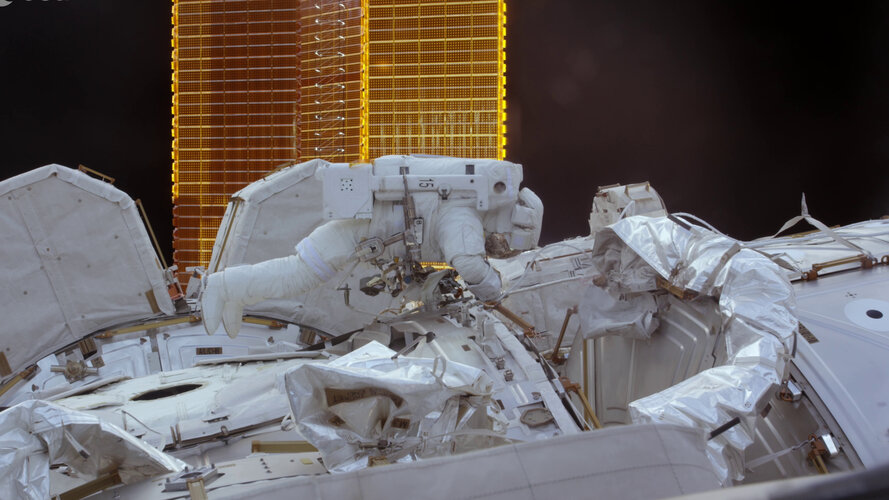 Video:
00:03:30
Video:
00:03:30
Work is under way to sort and assess applications from more than 22 500 ESA astronaut hopefuls. The rigorous selection process will take around 18 months. Initial screening to ensure that basic criteria are met will be followed by medical and psychological tests, exercises and interviews.
ESA plans to recruit 4-6 new astronauts through this 2021-22 selection round to support the future of European space exploration. This is likely to include missions to the International Space Station as well as the Moon. As part of the selection process, ESA is also assessing the feasibility of flying an astronaut






